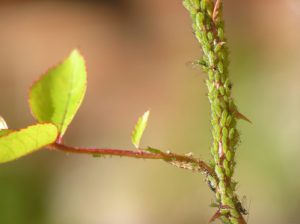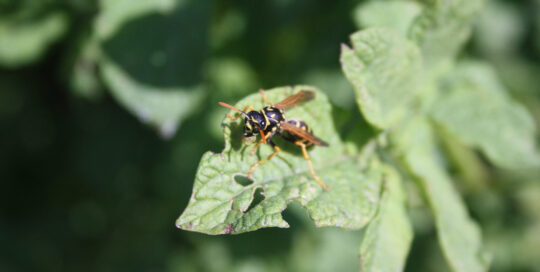More Aphids Than You Can Shake a Stick At
Views: 3572

So many times when we’re talking about an infestation of aphids, we simply say, “they’re are damaging the plant,” as if there’s just one type of the sap sucking insect. But there are over 4,000 species.
All aphids do have a few things in common, including being a soft-bodied insect that is fairly easy to kill. A hefty blast of water does the trick in many cases, and insecticical soap can usually take care of persistent infestations. They are also suspceptible to parasitic wasps, which is yet another reason to encourage these beneficial insects in your garden.
Aphids and Disease
The trouble with aphids is not only the damage they do, which involves literally sucking the life out of the plant, but also that they are a vector for disease. It’s common for them to transmit cucumber mosaic virus, bean common virus, and zucchini yellow mosaic virus. So you might have an aphid infestation followed by a viral problem.
With so many species, it’s good to know that some remain with their preferred host plant while many freestyle on what is available in the garden.
Here is a sampling of just a few of them:
Green Peach Aphid (Myzus persicae)
This little aphid (as if any of them are large) are a big problem in the southern states. They’re only a 1/8 inch long and might be pink or green, but all of them have red eyes. They often overwinter on peach and other fruit trees, but do significant damage in the vegetable garden.
Potato Aphids (Macrosiphum euphorbiae)
I think the Colorado potato beetle is bad enough to contend with on potatoes, but several types of aphids like them, too. Besides green peach aphids, potato aphids also feed upon potato plants. They come in pink and green variations, but are typically a bit larger.
Unfortunately, the potato aphid also likes tomatoes. And, like in so many other cases where aphids are involved, the damage doesn’t necessarily come from them themselves, but from the potential transmission of a virus. In potatoes it would be something like potato leafroll virus.
Green Apple Aphid (Aphis pomi)
Growing up in Ohio, I’m sure I’ve seen the result of a green apple aphid infestation since it’s very common on apple trees back there. The leaves curl and whither as they congregate on the undersides, and a heavy infestation can do a fair amount of damage. One of the easiest ways to keep them under control is to prune the trees each spring so they don’t have tender leaves to utilize.
Giant Willow Aphid (Pterochlorus viminalis)
What’s interesting about this one is it’s large (1/4 inch) for an aphid, plus it pretty much stays to its preferred host plant; namely willows. This might be an issue if your landscape has a lot of willows.
Rose Aphid (Macrosiphum rosae)
Anyone who’s grown roses has most likely had problems with the rose aphid. When it’s a bad infestation they’ll cover the stem and buds until it’s just a moving mass.
To avoid reaching that level, be vigilant in checking your roses. Squish or wash off small patches that you find.
To deal with them, you can spray your roses with a dormant oil spray, or bring out your trusty bottle of insecticidal soap. Although a healthy plant will successfully fend off a moderate infestation of aphids, you really don’t want them around your roses because of the disease transmission possibility. Keep after them to keep your roses healthy.
(The photo is copyright Anettelinnea from istock because I’ve never had them this badly on my roses, but I wanted to show something dramatic!)
Meet Amy Grisak
Amy is a freelance author and photographer in Great Falls, MT who specializes in gardening, foods, and sustainable agriculture. She provides information on every kind…
Amy's Recent Posts

Looking into the Crystal Ball for a Pest Report








